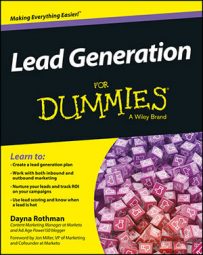Email marketing helps create personalized relationships with buyers over time. Without a focus on a middle-of-the-funnel strategy, many of your leads dry up and never become customers. Email marketing is a great way to keep in touch with leads already in your database. Send emails to your leads when you are launching a new product or service, promoting a new content asset, attending an event, and so on. Email is as relevant as ever before, with 94 percent of Americans more than 12 years of age using it regularly. Fifty-eight percent of adults check email first thing in the morning. So, email should remain a large part of your holistic lead-generation strategy.
Your emails should serve one of the following purposes:
Transactional: An operational email that could be related to a purchase or an event registration.
Promotional: An email meant to promote an action — downloading an ebook, signing up for a demo, and so on.
Relationship development: Meant to maintain your relationship with your leads.
Communication: Update or communicate some sort of information, like a newsletter or product announcement.
Reminder: A reminder that an event is approaching, such as a webinar or tradeshow.
Hopefully you have a wide variety of leads in your database. You have leads that represent all of your different personas and more. An important part of effective email marketing is reaching the right people and segmenting your database appropriately. For instance, you wouldn't send a lead in Boston an invite to an event in San Francisco. By having clean data and understanding how you segment your database for an email send, you can have much better results.
Keeping your data clean
The first step to proper segmentation is a clean database. What does this mean? In short, it means making sure the data you have in your system is the correct data. This means incorrect phone numbers, email addresses, duplicate contacts, and other bad data can basically stop up your funnel. If you aren't sending the right emails to the right email addresses, you will have angry leads and lots of bounce-backs.
You can employ data cleaning services like LeanData and Talend, who fix your data by identifying and repairing incorrect, redundant, or non-conforming data. Here are also some best practices to keep in mind for clean data:
Collect the same data points on every form: Identify the data you want to collect on a form and try to standardize the process. That means, if there are five things you want from a lead, try to keep that consistent. When you change one form, make sure the others are updated, too.
Clean duplicate data: Duplicate data is often considered a low-hanging fruit because it is easier to find and fix than some other data problems. An example would be two of the same accounts belonging to the same rep or one lead with multiple different email addresses or spellings of her name. Many customer relationship management (CRM) and marketing automation tools enable you to clean out duplicate data.
Standardize fields in your CRM and marketing automation tool: Make sure your fields are the same across the board. You can also easily bucket (or standardize) data to summarize all of the different answer possibilities. For instance, for someone's title, such as director of marketing, that data can be input in a ton of different ways: director, marketing; marketing director; and so on. Bucketing by common keywords and abbreviations helps you to standardize this process across your systems.
Segmenting and targeting your emails
After you have determined how clean your data is (and hopefully it is fairly clean), start thinking about segmenting and targeting. By highly targeting your communications, you can have 30-percent higher rates of leads opening your messages than if you're sending undifferentiated messages, according to the Direct Marketing Associations National Client Email Report.
Small, segmented sends are more engaging than large, untargeted sends. Why? Because it's impossible to truly speak to a person in an engaging way with a generic message to a large group.
Here are two types of relevant segmentation techniques that you should be using:
Demographic: Income, age, title, location, and so on
Behavioral: What your lead has done and how she has behaved — online body language
Behavioral targeting and segmentation have the most effect on your leads because you can ensure you are remaining relevant. As an example, say you see a lead has downloaded three ebooks about email marketing. Why not send him a follow-up triggered email with more email marketing best practices? According to Jupiter Research, targeting emails based on behavior increases open rates by more than 50 percent and conversion rates by more than 350 percent.
Here is a list of recommended behavioral triggers to use when segmenting and targeting your emails:
Campaign response to prior email: If a lead opened or clicked on a prior email campaign
Content interactions: If a lead downloaded or shared a content asset
Social interactions: If a lead commented on or shared a post on his social network
Buying stage: What buying stage the lead is in, as determined by a lead score
One-time buyer versus repeat buyer: How many times has a lead purchased from your company?
Transactional data: What has the lead purchased over time?
Customer anniversary: The date a lead became a customer
Cart abandonment: If a lead added an item to her online shopping cart, but never purchased it

